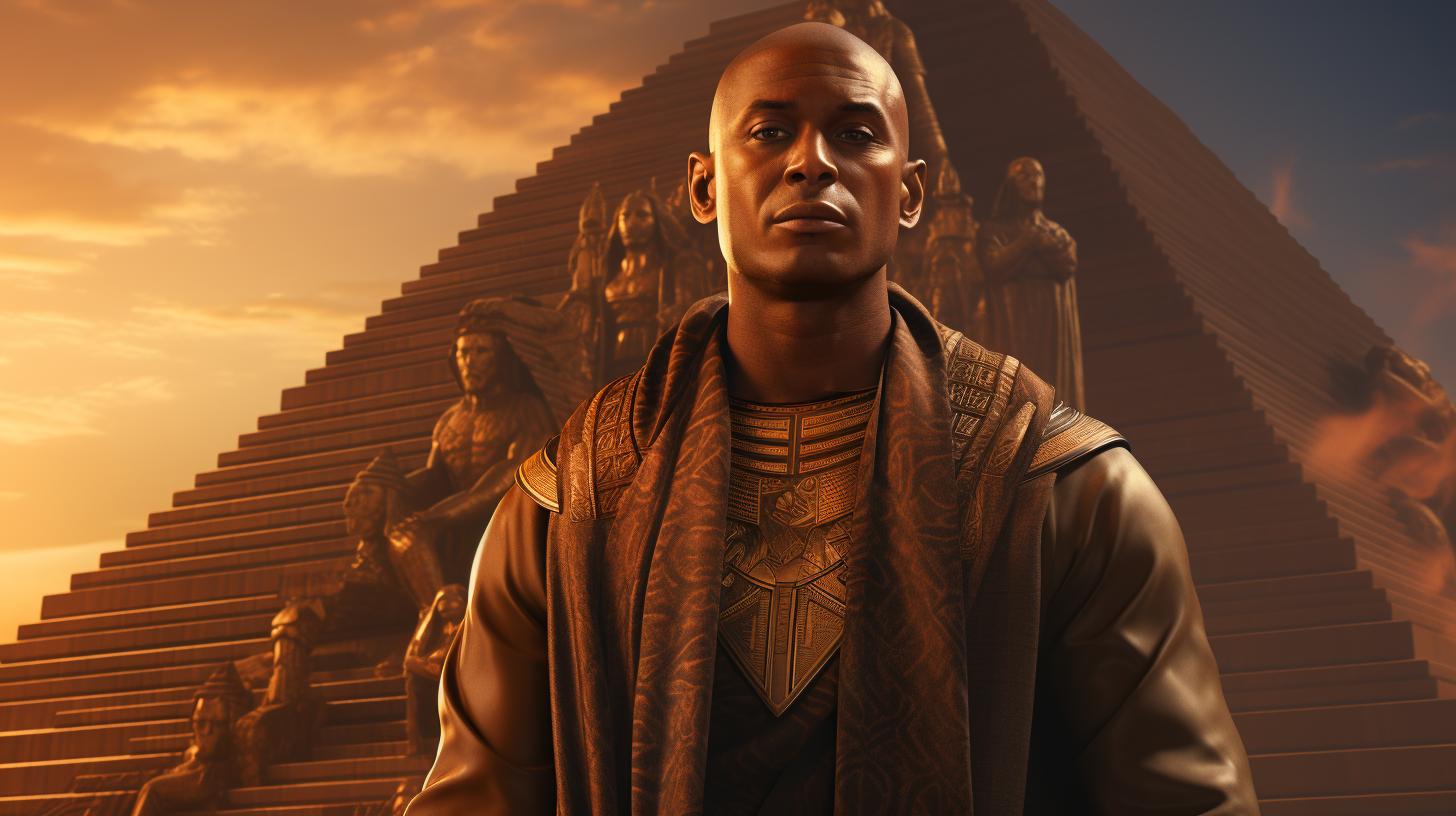What was Imhotep known for: Discovering the Architectural and Medical Genius of Ancient Egypt

Imhotep, an ancient Egyptian polymath, was known for his remarkable talents and achievements during the reign of Pharaoh Djoser in the Old Kingdom of Egypt. As an architect, he revolutionized Egyptian architecture with his innovative design of the Pyramid of Djoser, showcasing his mastery of construction techniques.
Imhotep also played a crucial role in the field of medicine, laying the foundations for ancient Egyptian healthcare practices through his authorship of the Edwin Smith Surgical Papyrus. His multifaceted expertise extended to being a trusted minister, priest, sculptor, and diviner, solidifying his esteemed position in Egyptian society and religion.
Imhotep’s influence remains profound, shaping both modern medicine and the cultural legacy of ancient Egypt.
Imhotep: Exploring the Legacy of an Ancient Egyptian Polymath
Imhotep, an enigmatic figure from ancient Egypt, left behind a profound legacy that continues to fascinate scholars and historians. As a polymath, he made significant contributions in various fields, leaving an indelible mark on architecture, medicine, and society.
This article delves into the life and achievements of Imhotep, shedding light on his early years and unparalleled rise to prominence.
Early Life and Rise to Prominence
Little is known about Imhotep’s early life, but his intellectual prowess and exceptional abilities propelled him to prominence. Born as a commoner, he defied societal expectations, ascending to the highest echelons of power and influence during the reign of Pharaoh Djoser.
Imhotep’s relentless pursuit of knowledge and unwavering dedication to his craft set him apart from his contemporaries.
Imhotep as an Architect: Designing the Pyramid of Djoser
Imhotep’s architectural genius is best exemplified by his groundbreaking design of the Pyramid of Djoser, located in Saqqara. This monumental structure, known as the Step Pyramid, marked a pivotal moment in Egyptian architecture.
Imhotep’s innovative approach revolutionized construction techniques, introducing intricate layers, and radically deviating from the traditional flat-roofed mastaba tombs.
Innovation in Ancient Egyptian Architecture: The Stepped Pyramid
- Unprecedented Design: The Step Pyramid featured six stepped layers, showcasing Imhotep’s mastery of complex structures.
- Symbolic Significance: The pyramid’s ascending levels represented the pharaoh’s journey to the heavens, emphasizing their divine status.
- Influential Impact: Imhotep’s design influenced generations of architects, laying the foundation for future iconic pyramids.
Construction Techniques and Structural Design
- Engineering Brilliance: Imhotep employed advanced engineering techniques, using large limestone blocks precisely cut and fitted together.
- Architectural Innovations: The Step Pyramid incorporated internal corridors, chambers, and underground tunnels, showcasing Imhotep’s mastery of structural complexities.
- Sustainable Building Practices: Imhotep utilized sustainable materials and construction methods, ensuring the pyramid’s durability and longevity.
Imhotep as a Physician: Pioneering Egyptian Medicine
Beyond architectural achievements, Imhotep demonstrated remarkable proficiency in the field of medicine.
Widely regarded as the founder of Egyptian medicine, he played a crucial role in developing medical practices that would endure for centuries.
The Edwin Smith Surgical Papyrus: Insights into Early Medical Practices
- Groundbreaking Text: Imhotep authored the Edwin Smith Surgical Papyrus, a seminal work documenting rational and scientific approaches to various surgical cases.
- Diagnostic Expertise: Imhotep’s text outlined systematic methods of diagnosis, examination, and treatment, laying the foundation for future medical practitioners.
- Unparalleled Surgical Knowledge: The papyrus provided detailed instructions for various surgical procedures, showcasing Imhotep’s advanced understanding of anatomy and surgical techniques.
Diagnosis and Treatment of Various Diseases in Ancient Egypt
- Holistic Healing: Imhotep’s medical practices encompassed physical, spiritual, and ritualistic aspects, emphasizing the interconnectedness of the body and soul.
- Herbal Remedies: He devised comprehensive treatments, utilizing herbal concoctions, potions, and poultices to alleviate ailments and promote healing.
- Medical Expertise: Imhotep’s vast knowledge of diseases and their symptoms enabled him to provide personalized and effective medical care to his patients.
Imhotep’s Roles in Egyptian Society and Religion
Imhotep’s remarkable abilities extended beyond architecture and medicine, as he played crucial roles in Egyptian society and religion, solidifying his elevated status.
Vizier and Chief Minister to Pharaoh Djoser
- Unparalleled Influence: Imhotep held the esteemed position of vizier, serving as Pharaoh Djoser’s chief advisor and administrator, shaping the direction of the kingdom.
- Promoter of Prosperity: His administrative prowess and foresight led to economic prosperity, fostering trade, industry, and cultural advancement.
- Architectural Visionary: Imhotep’s role as vizier provided the platform to bring his architectural vision to fruition, leaving an enduring mark on Egyptian history.
Priest, Sculptor, and Diviner: Imhotep’s Spiritual Connections
- Religious Significance: Imhotep held various religious positions, serving as a high priest and engaging in rituals and ceremonies associated with ancient Egyptian deities.
- Cultural Renaissance: His contributions as a sculptor revived artistic expressions, breathing new life into the visual legacy of ancient Egypt.
- Divinization: Following his death, Imhotep was deified, earning reverence as the Egyptian god of medicine and becoming a central figure in religious practices.
Imhotep’s Continued Influence and Reverence
Imhotep’s impact transcends time, leaving an enduring legacy that continues to shape modern fields and cultural perceptions of ancient Egypt.
Legacy in Modern Medicine: Impact on Healthcare Practices
- Rational Medical Approaches: Imhotep’s rational and scientific methods laid the foundation for the evolution of modern medicine, inspiring future generations of physicians.
- Heritage of Healing: Ancient Egyptian medical traditions, influenced by Imhotep’s pioneering work, have left an indelible mark on global medical practices.
- Continued Reverence: Imhotep’s name and achievements are highly revered, even in the modern world, with his contributions celebrated as a testament to human ingenuity.
Imhotep’s Cultural Significance and Remembrance in Ancient Egypt
- Cultural Icon: Imhotep’s influence extended beyond his expertise, symbolizing intellect, innovation, and the pursuit of knowledge in Ancient Egyptian society.
- Architectural Marvel: His architectural achievements, including the Pyramid of Djoser, stand as a testament to Imhotep’s legacy and continue to captivate visitors.
- Artistic Inspiration: Imhotep’s artistic contributions left an indelible imprint on ancient Egyptian culture, shaping the visual language and artistic expressions of subsequent generations.
Recognition and Reverence in Greece and beyond
- Transcending Borders: Imhotep’s reputation extended to ancient Greece, where he was equated with the Greek god of medicine, Asclepius.
- Cross-Cultural Influence: His deification and widespread reverence demonstrate the cross-cultural impact of Imhotep’s achievements and intellectual prowess.
- Enduring Veneration: Imhotep’s name and accomplishments continue to be revered, with his influence reaching far beyond the borders of ancient Egypt.
.









